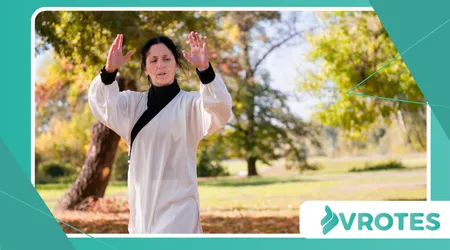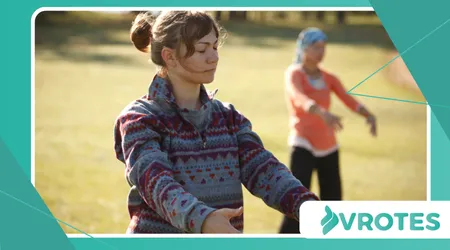Qi Gong Routines to Enhance Energy in Midlife

Qi Gong Routines. Life’s middle chapters often bring a sense of deceleration.
Anúncios
The boundless energy of our twenties and thirties begins to wane, and we find ourselves navigating new physical and mental landscapes.
This is where the ancient practice of Qi Gong, a cornerstone of traditional Chinese medicine, offers a powerful, accessible path to renewed vitality.
These Qi Gong Routines are not just exercises; they are a profound method for cultivating and managing your body’s natural energy, or qi, providing a holistic solution for the common challenges of midlife.
Qi Gong is a practice that links gentle movement, controlled breathing, and focused intent.
Anúncios
It is often described as “moving meditation,” a way to clear internal blockages and restore the natural flow of life force.
Imagine a powerful river, once flowing freely, now partially dammed by accumulated debris—the river is your energy, and the debris is stress, poor posture, and the general wear and tear of life.
Qi Gong acts as a gentle current, systematically clearing the blockages to let your energy flow freely again.
Tapping into Your Inner Reservoir of Energy
Our modern, fast-paced lives demand a constant output of energy. We are often depleting our reserves without ever stopping to replenish them.
This constant drain leads to the chronic fatigue, brain fog, and feelings of being “stuck” that so many people in midlife report.
Qi Gong directly addresses this imbalance by teaching you how to draw energy from your environment and circulate it internally.
It’s about building a sustainable energy source rather than just running on an empty tank.
Read here: Natural Detox Baths to Soothe Body and Mind
A 2021 meta-analysis published in the journal Frontiers in Medicine found that a significant majority of randomized controlled trials reported that Qi Gong exercise was beneficial for improving fatigue in patients diagnosed with various chronic diseases.
The findings highlight its potential as an effective, non-pharmacological intervention for energy-related symptoms.
This research underscores that the benefits extend far beyond a subjective feeling of well-being, providing a clear, evidence-based reason to consider the practice.
The Morning Routine: Awakening Your Body’s Potential
Starting your day with a focused Qi Gong Routines can fundamentally change its trajectory. Instead of jolting your system with caffeine, you can gently awaken it from within.
A typical morning routine might begin with simple warm-ups, such as gently swaying your body or rotating your joints to improve circulation.
These initial movements are crucial for lubricating joints and preparing the body for more complex forms.
One example of a powerful morning practice is the “Lifting the Sky” exercise. Stand with your feet shoulder-width apart.
As you inhale, slowly raise your hands, palms facing up, in front of your body and then overhead, as if lifting the sky.
See how interesting: Combining Reiki and Breathwork for Hormonal Harmony
Exhale as you slowly lower your hands. This simple, graceful movement stretches the spine, expands the chest, and focuses the breath, bringing a flood of oxygen and energy to every cell.
It’s a direct and powerful way to signal to your body that a new day has begun, and it is ready.

The Midday Refresher: Combating the Afternoon Slump
By mid-afternoon, many people find their energy levels plummeting. This is the notorious “afternoon slump,” a time of reduced productivity and a desire for a nap.
Instead of reaching for another coffee or sugary snack, a short Qi Gong session can be a game-changer.
These routines are designed to release stagnant energy and revitalize the mind without creating the wired, anxious feeling that stimulants often produce.
A highly effective midday exercise is “The Dragon Twists.”
++ Creating a Menopause Mood-Tracking Board
From a standing position, gently twist your torso from side to side, letting your arms swing loosely and tap your lower back and abdomen.
Keep your movements fluid and your knees slightly bent.
This action stimulates the organs, releases tension in the spine, and improves blood flow to the brain, which can immediately help to clear mental fog.
It’s like shaking a bottle of settled water—the contents become a vibrant, integrated whole.
Understanding the Mechanisms: How Qi Gong Works
The benefits of Qi Gong are rooted in its influence on the body’s physiological and neurological systems.
For instance, the practice stimulates the parasympathetic nervous system, responsible for the “rest and digest” response, which is often underactive in our stressful lives.
This helps to reduce stress hormones like cortisol.
The deliberate, deep breathing techniques increase oxygen saturation in the blood, nourishing all of the body’s tissues and improving cognitive function.
Furthermore, Qi Gong helps to improve interoception—the ability to sense the internal state of our bodies. As we age, this connection can weaken.
Regular practice helps to rebuild this critical mind-body link, allowing us to better understand our physical needs and respond accordingly.
This heightened awareness is an invaluable tool for managing health and preventing burnout.
The gentle movements also enhance flexibility and balance, which become increasingly important as we get older.

A Table of Common Midlife Challenges and Corresponding Qi Gong Benefits
| Midlife Challenge | Qi Gong Benefit |
| Chronic Fatigue | Increased energy flow and vitality; improved mitochondrial function |
| Stress and Anxiety | Activation of the parasympathetic nervous system; reduced cortisol levels |
| Stiff Joints and Muscles | Enhanced flexibility, joint lubrication, and range of motion |
| Poor Posture | Strengthens core muscles; improves spinal alignment and stability |
| Mental Fog | Increased oxygenation to the brain; improved focus and clarity |
The above table illustrates the direct correlation between common midlife complaints and the specific, tangible benefits of a consistent Qi Gong practice.
The improvements are not just superficial; they address the root causes of these issues.
The Holistic View: Beyond the Physical
The practice of Qi Gong is about more than just the body. It is a meditative art form that fosters a sense of inner peace and emotional balance.
Many people in midlife feel overwhelmed by responsibilities, from career demands to family caregiving.
The focused attention required by these routines provides a much-needed mental break.
This time-out allows the mind to decompress and reset, leaving practitioners feeling more centered and resilient.
Approximately 40% of American adults between the ages of 40 and 60 report feeling more tired than they did in their younger years, with a significant number attributing it to work-related stress.
While this statistic is sobering, it also highlights a clear need for effective, sustainable solutions.
Adopting a practice like Qi Gong offers a way to counter this trend proactively, by building internal reserves and fostering a sense of control over one’s own well-being.
So, could a simple ten-minute daily practice truly change your midlife experience for the better?
The evidence, both anecdotal and scientific, suggests it’s not only possible but probable.
These Qi Gong Routines are a powerful investment in your long-term health, offering a bridge to a more energized, balanced, and peaceful life. The power to reclaim your vitality is already within you.
Frequently Asked Questions
Are Qi Gong Routines difficult to learn for a beginner?
No, Qi Gong is highly accessible. The movements are slow, gentle, and can be adapted to any fitness level, even for those with physical limitations.
Most beginners can learn a simple routine in a single session.
How often should one practice Qi Gong to see results?
Consistency is key. Even a short 10-15 minute daily practice can yield noticeable benefits over time.
For more profound results, aiming for a 30-minute session a few times a week is an excellent goal.
Is Qi Gong a substitute for other forms of exercise?
Qi Gong complements other forms of exercise perfectly. While it improves flexibility, balance, and internal strength, it is often best combined with other activities like walking, swimming, or weight training for a complete fitness regimen.
Are there any specific Qi Gong Routines for sleep?
Yes, many routines are designed specifically to promote relaxation and improve sleep quality.
These often involve more gentle, grounding movements and a strong focus on calming the breath to prepare the body and mind for rest.
